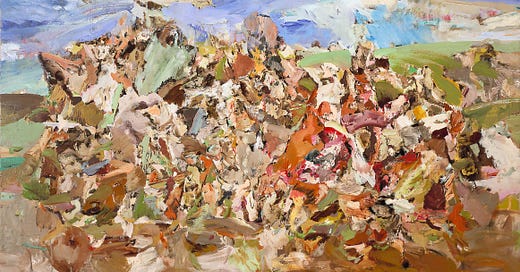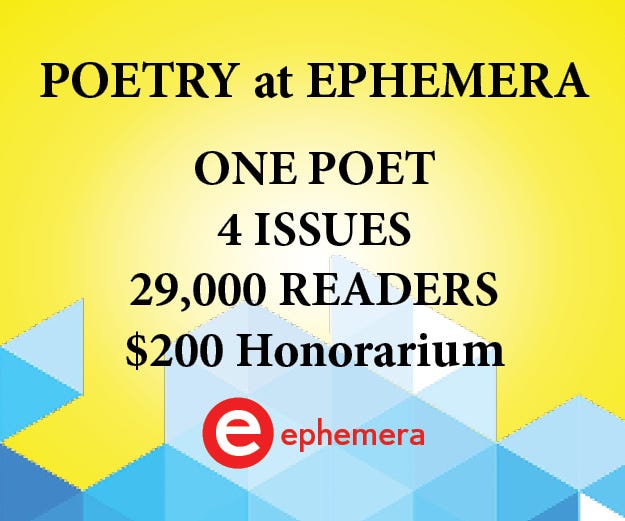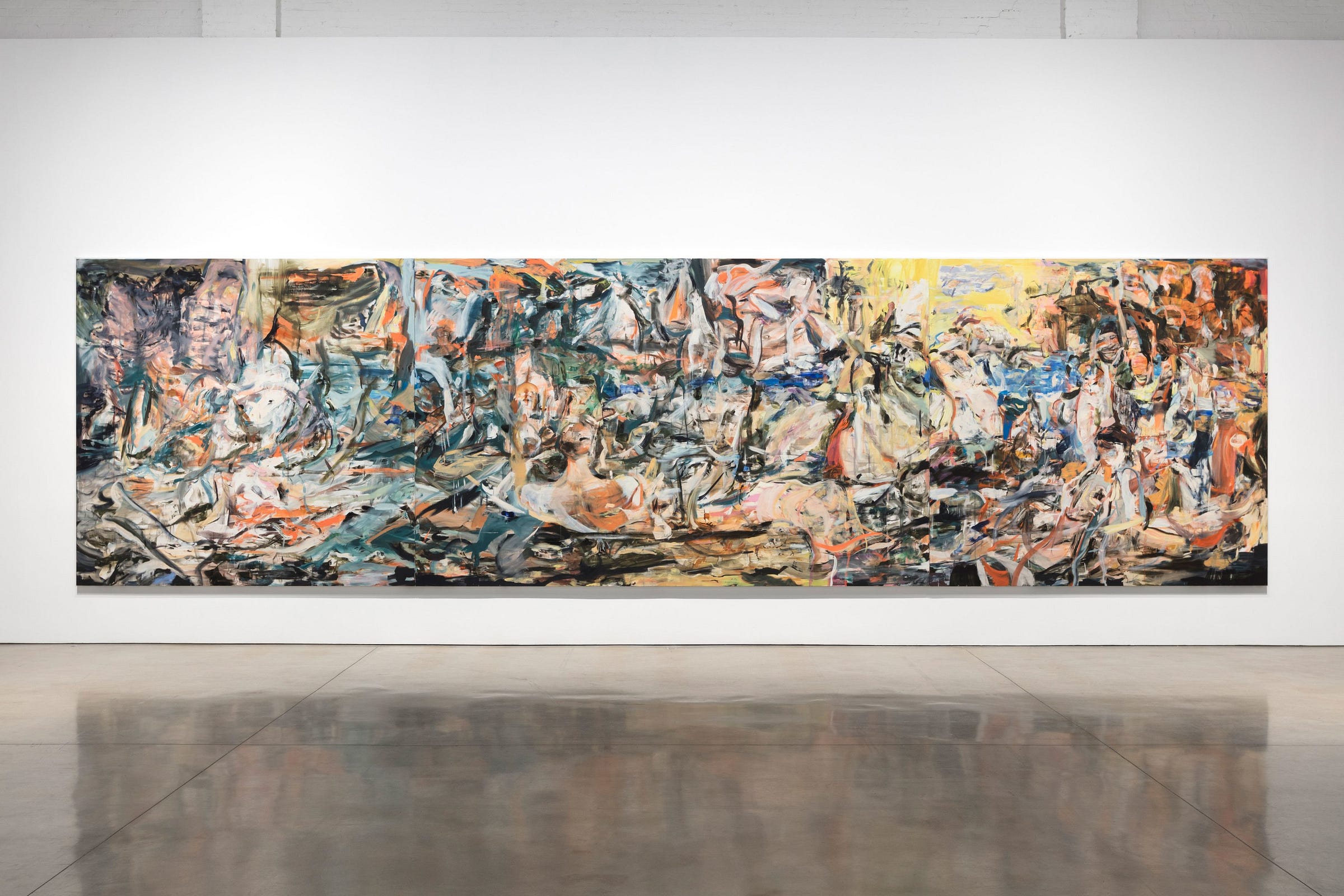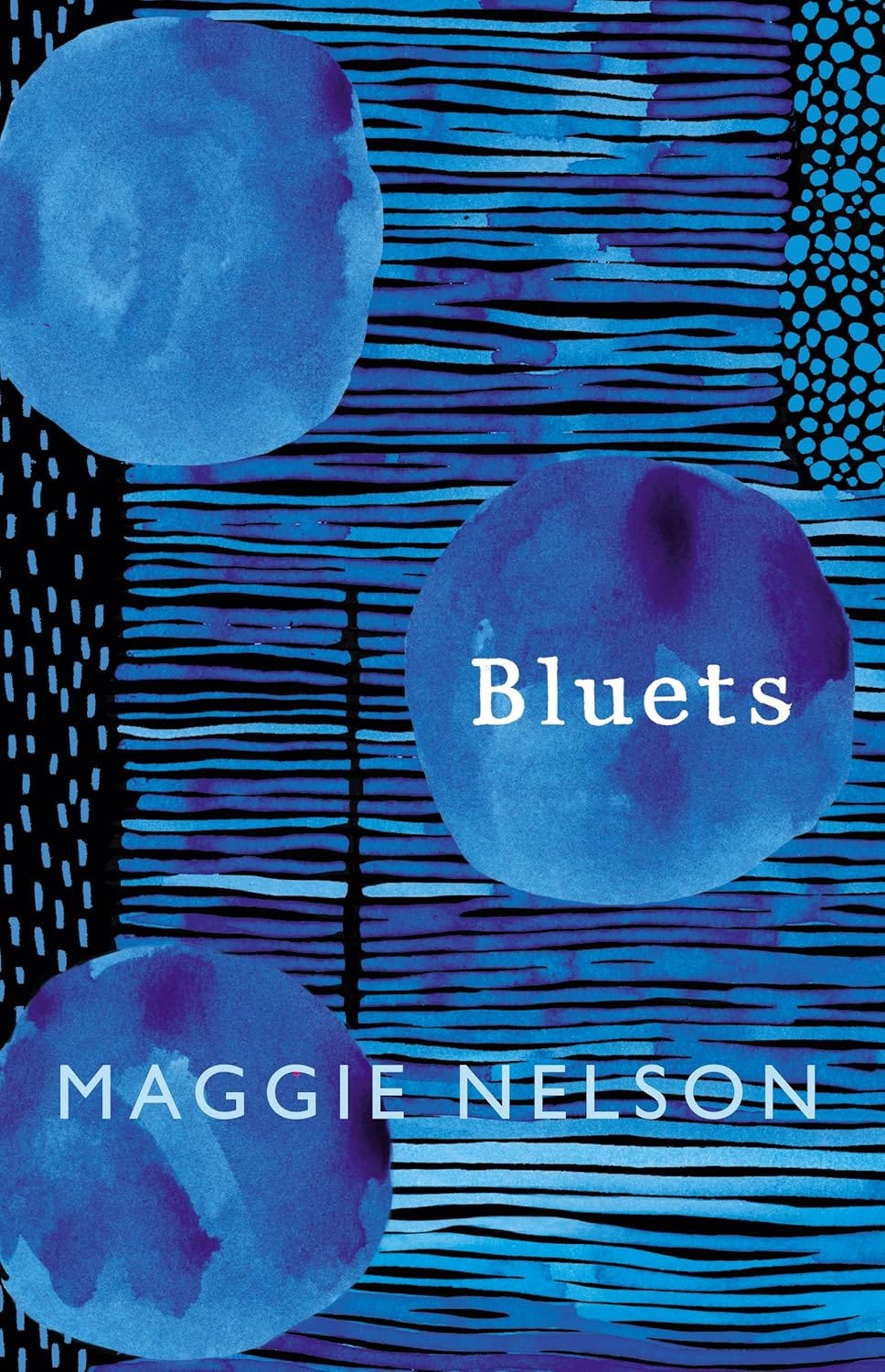Welcome to the Ephemera Newsletter free edition, Prijateli! (Macedonian for “friends”)
As you may be aware, we’re running our Good Contrivance Farm Residency for a third time. Early deadline is July 31! We hope folks will submit early. Yearly paid subscribers can submit for free. We’ll send you a special link next month. Please join us to support the letter so we can continue to bring weird tidbits, mini essays, artists and music from a writerly lens, opportunities and other literary and creative ephemera. We have 29k general subscribers and followers but only a small amount of our readers are paid subscribers—thanks a million to those folks! We’d like to get to 200 paid subscribers at any level. That would really help us continue on. And if we hit that level (or beyond) we want to bring new programs into the fold—in our paid subscriber updates we discuss a residency in San Juan, Puerto Rico. Thanks and onward!
Another round of thanks are in order to all who submitted to poetry in May for our July issues. And again, thanks to Jennifer Gauthier who will be the poet for the month of July! You can review her poems altogether once they publish as well as her artist statement and bio on this dedicated post on our Substack page. We thank you for checking out Jennifer’s Gauthier work.
On to our standard content matters and reminders:
Monthly Invite to Submit: Submissions are in for the August issues. We look forward to reading! We are open for September now. July 31 is the deadline. If you are a paid subscriber to Ephemera, you can submit to poetry @ Ephemera for free as a membership perk! (We email you a secret link at the end of your second consecutive paid month and every month thereafter for as long as you are a paid subscriber). Free subscribers and anyone else can submit, too, with the reading fee and can submit up to 10 poems. Paying the reading fee will grant you 1-month paid access to Ephemera’s full letter. Learn more or:
In Brief…this week’s features:
Thoughts on Cecily Brown’s wild and full paintings.
Listening to Sabrina Carpenter’s pop hit “Feather.”
July’s poet, Jennifer Gauthier second of four poems, “Said the bee.”
Our weekly lists:
3 magazines with open calls
3 awards/prizes
3 recent job listings for editors and writers.
Interesante: In this issue, we look into how people think with an article from Collab Fund.
Book Recs, bonus content, and our mini-essays to start!
Last Issue, Jul.1 which is free for all subscribers. Read here.
Merci. Danke. Kiitos. 고마워 Go-ma-wo. Cảm ơn. Xiè xiè.
Ephemera
Late afternoon thunder storms trumpet the fall of evening where we are these last two weeks, locked in to our home routine having run around the better part of May through early July. There’s something comforting about a bright hot day tucked away by dark clouds and warm rain. The sinuous stream we cross commuting the short mile to and from our office, tucked away down a deep ravine with green areas flanking the drop off and camouflaged by wide roadways that don’t signal “bridge,” bulges considerably, overtaking the sand bars and rock outcroppings where on weekend walks we tend to search for turtles. Blast the speed with which the water moves during these rains, for we can’t spy the peripheral life that makes small cities so pleasant. But the rushing yields its own charm, mesmerizing in a way, appealing in a deep vascular sense as in water yields, as in salubrity accompanies the gurgling of creeks and rivers turgid during the hot dry days. Our deep cellular memory pangs. Throbs under the canopies of a cooling copse. Pings along the shoreline, pips and piques with the breeze. You can connect with the earth while running—as we have—but being slow, wading through the late summer heat tunes the senses and connects our adulting self with the previous versions of self (maybe even future, too) that linger in the background, in our cellular memory, youth back to childhood, and maybe even genetic memories of our parents and, back still, ancestors. We’re being slow. Communing and sensing while comfort and conscience are as replete as our waterways.
“I would love to be able to make clear figuration. I just don’t know how you do it. … I think some people can do it but I just can’t. Someone just reminded me that [Gerhard] Richter used to call his abstractions “realism.” I like the artifice of painting and the fact that it’s this very fake world. But in a way, a strict representation is the most fake of all.”
—Cecily Brown, interview in Brooklyn Rail
And even in these slow moments, we seek summer diversion. Maybe not excursional. We want a blip of easy-living via easy-listening. Pop songs pop into mind, pop on the old boombox. Pop TV and pop movies, too. We’ve spent the better part of the year adulting and learning and sitting at our desks serious and studious. A little romp around the fast-culture landscape can be in order. There are bits to glean, vibes to catch. With music and movies, often rising creators will slip in little experimental bits, try something new within a tired genre, use audience expectations against them to create surprise. Watch for this. Watch for the twists. Watch for the subversions—these moments may also indicate where culture is headed. One person’s experiment can become another decade’s worth of mimicking—thereby becoming a new standard a new trend. Even when there’s not much to glean, we can let ourselves be seduced by easy entertainment. A little rest while the summer blooms.
Blagodarnost!
(Gratitude)
Poetry by Jennifer Gauthier
Said the bee We smelled you before we saw you little girl-peanut butter-lemonade-sweat sheathed in July heat heart beating and lousy with naïve confidence. All the hive suddenly alive to your presence. In no more than a moment we dove. We follow you stunned, running down the hill to home. We attack your back and die trying. Left behind stingers and some of our friends, but we had to defend and defend we did. Taught you a lesson, gave you a story to tell about that time you went in search of a beehive and, well, found one.
Music: Sabrina Carpenter
Hot pop exquisite trash purveyor, Sabrina Carpenter, is pretty popular this summer (we’re told). Listening data and articles in pop rags seem to confirm. In general, to actively and predominantly listen to pop music like this after the age of 25 should be an act of reluctant dumpster diving. Not that the music isn’t catchy or even good. This song is great! Others like it can also be musically impressive or innovative (kind of—pop producers are great at exquisite borrowing, and you can see this if you listen to indie and more Avant Garde artists from whom the producers steal to freshen up the exhausted pop realm). While still on our soap box, people should orient toward adult understandings, interactions, and structures of thinking by the time they’re in their mid-twenties to the point where frequently listening to music (and taking it seriously or countenancing it as anything useful other than a guiltily fun mini-ride—such as how we treat fast food) created like crack for teenagers and the culturally reinforced too-long-in-adolescence should be eschewed for more sophisticated art.
That said, pop writing is not nearly as problematic. And pop music can be mined for interesting approaches to making sounds and topics listenable and fun—a reader wants a bit of fun now and then.
Not to hate on Carpenter particularly. Her album seems more nuanced than we’re letting on and we’re promoting her song because it’s fun and she’s talented. There will always be pop music as there will always be youth who enjoys consuming it because they connect with the sentiment and because their palates are green and because there’s an industry that makes their exquisite garbage so easily accessible. Too, if you have talent, you’re quickly identified and funneled into the industry, which becomes the path of least resistance and therefore easily accessed in terms of career opportunities. You can’t entirely fault folks who’d like to be heard.
“We wanted to make this song about all the s(h)—ty events happening in my life, because it's so much more fun to turn it into a positive than to sit in the sadness.”
—Sabrina Carpenter, Interview on Grammy.com
Carpenter’s music has been buttressed by her acting. She’s been on TV and in movies. Perhaps her biggest leg up was being cast by Disney for the Boy Meets World spin off Girl Meets World that ran from 2014 through 2017. From 2014 through this year, she’s released six studio albums, the most recent one featuring another big summer hit, “Espresso” (nearly a billion listens on Spotify and it just came out…). She’s been opening for Taylor Swift’s Eras Tour in Latin America, which hasn’t hurt her mainstream appeal. The song we’re interested in, “Feather,” has nearly 600,00 listens on Spotify and hit 21 on the Billboard Hot 100.
We’re interested in the vocals. The instrumentation is solid, pleasant, fun, boppy. It’s summer. Late July. Why not bop around and not take things too seriously? The lyrics are sort of whatever when you listen to them particularly—much in the way of most pop music and, frankly, most music in general (we’ve been binging on lyricless tunes for years now). It’s her note progression and the timbre of her voice. It’s lovely and variegated and delivered with a verve we can’t exactly describe that elevates her, at least in this song, over the ocean of other pop singers striving out there at the moment. It’s light. It sort of conveys featheriness. And we’re keen to learn from artists, even those in silly genres.
Her voice reminds us of a couple of Italo Calvino’s bits of advice—maybe two combined—in his advice book to writers, Six Memos for the Next Millennium, a book we’ve mentioned before in this letter. Carpenter’s voice and delivery features two of Calvino’s writing virtues, those of Lightness and Quickness. There’s a deftness to her note-giving. It contains personality, emotion and proficiency. We can get behind that. We can look to mimic it when we need to. Sometimes writers forget to be light, forget that it’s OK to be amusing. The reader wants a tickle now and then. Maybe even to be surprised with good humor and alacrity in the face of hurt or tragedy (Carpenter’s song was in response to several relationship foibles and other negativity going on in her life, which she transmuted into positivity). Sometimes we can bop or laugh or convey more subtle despair through humor or levity. There are plenty of poems that do this perfectly—poets are to be closely watched. We prose writers should have a listen and a dance. See if we can’t get our readers to up and bop around on occasion.
Interview with Grammy.com
Writers Submit: 3 Magazines
Publishing for over a decade, the magazine is seeking 2,500 word nonfiction pieces with topical relevance, and reviews on TV, Film, Books, and other media subjects for online publication. OPENED JULY 1
The biannual journal published by Syracuse University is looking for work in all genres. They have published many great pieces in their 50 editions, and offer other publication opportunities. OPENED JULY 1
Published online by the Black Earth Institute, AP is reading poems, prose and essays for the theme of electoral issues and justice. They have published some amazing works throughout the years. DEADLINE AUGUST 1
Weekly Artist: Cecily Brown
Daughter of a novelist and art critic, the London born and raised Cecily Brown received a BFA from the Slade School of Fine Arts in 1993 before moving to New York City in ‘95. Shortly after arriving in NYC, her career began to expand and she became more well known, spurred, in part, by Charles Saatchi’s (of Saatchi Gallery) patronage. Her work now routinely sells at auction in the low to several millions. She exhibits around the world and her painting and drawings are collected by top museums, with The Hound with the Horses' Hooves (2019) recently going to the Yale Center for British Art. Brown was named as one of the most influential people in the world in 2018 by Time magazine.
Brown is known for her energetic and gestural paintings characterized by their vibrant colors, dynamic brushstrokes, erotic undertones, and, perhaps obscurely, attention to the human form. She falls into the abstract expressionism category though her work feels a bit different, a genre unto herself perhaps. Her influences include de Kooning, Francis Bacon, and Joan Mitchell to name a few of the most notable. She has said she draws inspiration from pop culture, literature, and, importantly, the work of other painters—painting history, so to speak, which, perhaps a bit tongue and cheek, includes previous iterations of herself per her interview response in the pull quote below.
“‘The nice thing about getting older as an artist is that you have your own work to draw on,’ Brown says. ‘I’m someone who always draws on other people’s work, so now I can steal from myself as much as I have from other artists.’”
―Cecily Brown, in Apollo-magazine.com
We’re drawn in by the promise of, by the anxiety one might enjoy when on the verge of recognizing a pattern but not quite sure if one is correct in their seeing. We can sometimes see the figures, sometimes shapes, sometimes just a mess of color; and color is a major point of interest in these works. The hues are particular to her, or so it feels. maybe it’s their patterning or the juxtaposition of different saturations; they’re pleasant and appealing, exuding warmth while set amidst cooling tones. Maybe it’s emotion complexly expressed. There’s an enoughness to the point of fullness in the bends and blots of these paintings. Sometimes a too-much-ness as in the two triptychs. We’ve not seen these in person, but we imagine a deep visceral response when up close, when face to face with the movement and color, what’s likely also a compelling texture rendered via oil paint.
The jumble offers a type of counterpoint to our thinking on neat pop songs. Maybe deconstruct everything to the point of pieces, mix them up, add in some notes of beauty that may or may not serve the meaning but serve their own beautiful ends, and let the hulking mass burst out, splintery, and, simultaneously, threaten to implode, fiery or coolly. We can use abstract moments to emphasize our emotions and imaginings, let the reader construct meaning out of the pins and pikes, the flares and sprays, the ripples…we can serve the simple in this way, imbue it with context and connotation. Maybe the complex is better off fiery and wild across sets of three. Not always. Sometimes. Maybe the elision of necessary components filled in by and with fractious elements of verve can speak about the loss of particularity, such as in remembrance. Maybe Brown’s figure are put to violet and orange flames, allowed to burst across the whole work with equal fierceness at all points at the same time, for many moments, then captured with a sort of meditative stroke. Use these tactics with discretion and precision. But let your experiments burst and gleam.
Interesante: How People Think
From: Collab Fund
— (5 min read/10 min study)
“Everyone belongs to a tribe and underestimates how influential that tribe is on their thinking.”
Written by the author of The Psychology of Money, this interesting post gets into 17 way sin which people think and behave from a perspective of things may change rapidly but people tend to be the same over time. Reading articles such as this is useful. We can check our notions and the ways in which we’re writing people in whatever genre we happen to be working in. It’s a good summary with some interesting takes and insights, along side quotes and examples. —Read the article.
Prizes/Awards/Stipends Winter ‘24
Aspen Words Fiction Literary Prize awards $35,000 to one published writer, alongside recognition & travel funding for finalists to attend the award ceremony. Selection will illuminate social issues. $35k. $95 fee (for publishers). DEADLINE AUGUST 7
Grayson Books Poetry Contest awards $1,000 and publication to one full length book of poetry. They’ve published over fifty books and have other publication opportunities. $1k + Pub. $26 Fee. DEADLINE AUGUST 15
Summer Short Story Award for New Writers gives $3,000 and publication at The Master’s Review to one new writer's short story. Second & third prizes w/ awards and publication. $3k + Pub + Runners Up. $20 Fee. DEADLINE AUGUST 25
EPHEMERA’S RESIDENCY:
Good Contrivance Farm
We’ve teamed up with Good Contrivance Farm for a 3rd time! We’re sponsoring up to two (2) writers each for a 1-week stay and a travel stipend to the Good Contrivance Farm Residency in Maryland.
1 and up to 2 applicants will be chosen after submissions close
1-week on the farm per person (valued at ~$900)
$200 stipend
Total Value: $1100
$30 application fee (for early applicants before July 31) $40 thereafter
or
Bookstore: Guides, Gifts & Classics
Please consider supporting our letter and literature by buying books. It helps us and others! Bookstore via Bookshop.
The Trope Thesaurus:
Last Issue we’re rereading Maggie Nelson’s Bluets:
»»»Remember last week’s letter has urgent deadlines!«««
Thank you for subscribing to Ephemera. We appreciate your support very much! It means a lot to have you as a reader and paid subscriber. We look forward to growing the letter and bringing you new content and conversation along side our staples. At present, we’re considering creating a book volume containing a large part of our content, including artwork and essays. We’re also considering other projects, such as a monthly podcast, mini-videos, and a Q&A with our editors. Let us know if you have any ideas on how we can improve.
~~~Zbogum~~~
(Goodbye)
*
*
*
**Select Job Postings**
Stanford: Writing Faculty. FT + TT. 3+ Yrs exp. $100k-$240k. Stanford.
AspreyGroup: Sr CW. FT. 7 Yrs exp. $100k. Remote.
Inizio: Sr. CW. FT. BA/MA+ 3 yrs exp. $70k-$100k. Remote (Cary, NC).
Ephemera Programs
Poetry at Ephemera:
Testimony from our previous Residency Selectee:
“From the moment I arrived at Good Contrivance Farm for my writing retreat, I was captivated by its tranquil beauty and knew I was at the right place at the right time. The farm is tucked away in a quiet picturesque rural area, north of Baltimore, and has serene orchards, majestic trees, and lovely Victorian farm buildings. I often found myself walking around the farm in quiet contemplation taking in the beautiful landscape. During these walks, friendly dogs and a gentle cat became my ‘writing companions.’ Exploring nearby nature preserves and local shops further enriched my experience. As you can imagine, these combined experiences made it easy to write and write I most certainly did. In fact, it was one of the most productive writing weeks I've had in quite some time as I was able to shut off the usual perfectionist voice in my mind and just let the words flow. Part of this was because of the living quarters. The cozy Hen House Cottage itself was a haven, boasting a diverse library, bluetooth sound system, inspirational notes from former visiting artists, and most importantly, a comfy bed—each detail contributed to a memorable stay and reminded me that simple pleasures often yield the greatest joy and creativity. Overall, I am deeply grateful for the opportunity to grow and create in a place so steeped in history and natural splendor. Good Contrivance Farm truly lives up to its name and is quite a special place for artists. I plan on returning and spreading the word. I hope that all artists have a chance to create in such an inclusive, safe, and charming space.”
—Monique Harris










